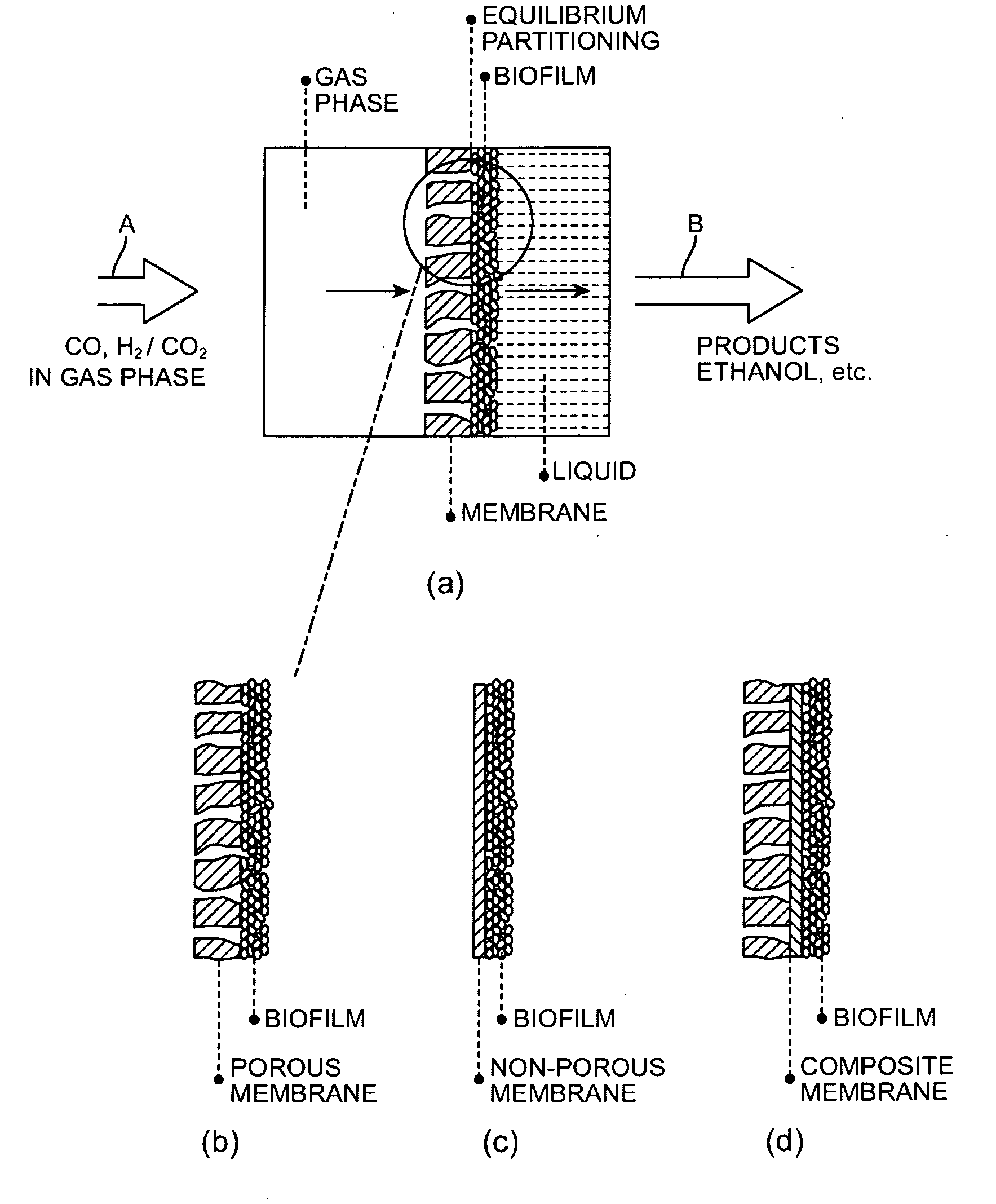Process to sequence bioreactor modules for serial gas flow and uniform gas velocity
a bioreactor module and gas velocity technology, applied in the direction of biofuels, microorganism fixing/supporting apparatus, fermentation, etc., can solve the problems of poor contact conditions, reduced gas conversion rate and condensation of liquids therein, and reduced the productivity and selectivity of such systems
- Summary
- Abstract
- Description
- Claims
- Application Information
AI Technical Summary
Benefits of technology
Problems solved by technology
Method used
Image
Examples
example 1
[0087]To analyze a specific membrane operation and geometry, a module with 275 0.2 meter-long microporous polyethylene hollow fiber membranes was used to estimate water vapor transfer coefficient, K. Fiber inner diameter and pore size was 410 μm and 0.4 μm, respectively. Relative humidity in the inlet and outlet gas was measured with a psychrometer (RH92 model, Omega Engineering Inc.) at an ambient temperature of 37° C. When gas flow rate was 1 L / min (or 0.46 m / s in fiber lumen), relative humidities in inlet and outlet were measured at 0.05 and 0.945, respectively. Finally, water vapor transfer coefficient, K, was calculated at 6.7×10−4 M / s using Eq. 2.
[0088]This K value again can be put in Eq. 2 to calculate the distance (L) required to saturate gas traveling through lumen. Under the identical condition used in the above experiment, the relative humidity of the gas increases to 99% before it travels 0.06 m. As mentioned earlier, water vapor starts to condense as soon as it saturate...
example 2
[0089]The experiment of Example 1 was repeated with a commercial module, Liqui-Cell® 2.5×8 (Membrana GmbH, Germany) under identical condition. The membrane fibers in the module were micro-porous like the membrane used in the above Example 1. The inner diameter of the membrane fiber was 220 micron. The diameter and length of the module were 63.5 mm and 203 mm, respectively. A very high water vapor transfer rate kept the relative humidity in the exit gas always above 99% even at the maximum gas flow rate allowed by the experimental setup, i.e. 7 L / min. Since the water vapor transfer coefficient, K, was not obtainable under this condition, the minimum water vapor transfer rate (Kmin) was calculated for the condition. When gas velocity in membrane lumen is 0.1 m / s, the relative humidity of the gas reaches 99% before it travels 0.03 m based on the Kmin, i.e. 7.7×10−4 m / s.
example 3
[0090]One more experiment was run with a non-porous membrane, SuperPhobic® 2.5×8 (Membrana GmbH, Germany), which did not have a micro-porous layer. Instead it had a non-porous layer that prohibited direct water vapor evaporation through membrane. As a result, water vapor transfers were inherently lower than those of porous membranes. The dimensions of this module were identical with the Liqui-Cell® module used in Example 2. With a gas flow of 0.83 L / min, relative humidities of inlet and outlet gas were measured at 0.05 and 0.794, respectively. Consequently, water vapor transfer coefficient, K, was calculated at 2.08×10−5 m / s using Eq. 2. The required membrane length to get a relative humidity of 99% in the outlet when gas travels at 0.10 m / s was calculated at 1.11 m. Due to a gas volume contraction in membrane lumen in real fermentation conditions, the required membrane length to saturate the syngas would be a bit shorter than 1.11 m.
[0091]In syngas fermentation with a biofilm attac...
PUM
| Property | Measurement | Unit |
|---|---|---|
| wt % | aaaaa | aaaaa |
| wt % | aaaaa | aaaaa |
| surface area | aaaaa | aaaaa |
Abstract
Description
Claims
Application Information
 Login to View More
Login to View More - R&D
- Intellectual Property
- Life Sciences
- Materials
- Tech Scout
- Unparalleled Data Quality
- Higher Quality Content
- 60% Fewer Hallucinations
Browse by: Latest US Patents, China's latest patents, Technical Efficacy Thesaurus, Application Domain, Technology Topic, Popular Technical Reports.
© 2025 PatSnap. All rights reserved.Legal|Privacy policy|Modern Slavery Act Transparency Statement|Sitemap|About US| Contact US: help@patsnap.com



